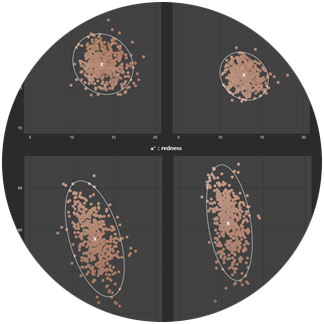Boram, the Ph.D. candidate of Color Lab, has published a research article, entitled “Method and analysis of color changes of facial skin after applying skin makeup” as the first author in the Vision Research Journal. This collaborative study, conducted with Cosmax, focused on quantitatively analyzing skin color changes before and after makeup in Shanghai, China. The study developed and applied remote study methods, leading to derived results. The results revealed that makeup led to brighter, less reddish, and less yellowish facial colors, resulting in a paler skin tone. However, no significant correlation was found between individual skin color characteristics and the choice of liquid foundation, nor did the changes in color differ based on makeup use frequency or skill among the subjects.
Keywords
Facial skin color, Chinese females, Skin makeup, Liquid foundation
Abstract
This study investigated facial skin color differences before and after makeup. Toward this goal, a photo gauge, devised with a pair of color checkers as a reference, collected face images. In addition, color calibration and a deep-learning method extracted the color values of representative areas of facial skin. The photo gauge photographed 516 Chinese females before and after applying makeup. Then, the collected images were calibrated by referencing skin color patches, and the lower cheek regions’ pixel colors were extracted using open-source computer vision libraries. Following the visible color spectrum of humans, the color values were computed in L*, a*, and b* of CIE1976L*a*b*. The results showed that the facial colors of the Chinese females changed to become brighter, less reddish, and less yellowish after applying the makeup, resulting in a paler skin tone. During the experiment, subjects were given five varieties of liquid foundation to choose one sample that best fits their skin. However, we failed to find any noticeable relationship between the individual’s facial skin color characteristics and the liquid foundation selected. In addition, 55 subjects were identified according to their makeup use frequency and skill, but their color changes did not differ from the other subjects. This study provided quantitative evidence of makeup trends in the Shanghai region in China, and the method proposes a novel approach toward remote skin color research.
Link to the article : https://doi.org/10.1016/j.visres.2023.108247


